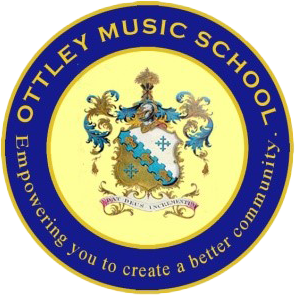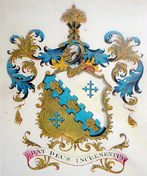From the College of Arms, London, 1848
Ottley Family Crest 1857
ARMS–Or and Argent, a Bend Nebly between two Cross-Crosslets Azure.
CREST–In front of a Garb Or, three Arrows, two in Saltire and one in Pale, points downwards, Sable.
MOTTO–Dat Deus Incrementum (Latin), God Gives Increase (English).
This Ottley family crest represents the line of Ottleys that on the command of James II and George III went to East India and to the Caribbean (West Indies) to colonize the islands from as far back as the middle 1600s. According to a diary of 15-year-old Elizabeth Ottley (1757-1801), there were several musicians who were friends of her family, Richard Ottley (1730-1775) being her father, who lived in a manor called Dunstan Park, in Thatcham in County Berks, and they spent several days of the Christmas holiday of 1772 in their home, from Wednesday, December 23 until Sunday, December 27.
History shows that these musicians were of the English court of King George III and Queen Charlotte who were themselves musicians, cellist and harpsichordist/singer, respectively. The musicians that Elizabeth Ottley named specifically in her diary are:
- Johann Christian Bach (1735-1782), known as the London Bach, was the youngest son of Johann Sebastian Bach, chapel master of Queen Charlotte, composer known for his six concerti for harpsichord and string orchestra, Op. 1, his sonata for violin and piano, Op. 16, Trios for violins and viola, Op. 4. 15-year-old Elizabeth practiced the concerti daily, and when the musicians came over Christmas of 1772, she played them with their accompanying her.
- Carl Friedrich Abel (1723-1787), Chamber musician of Queen Charlotte, was one of the last famous players of the viola da gamba as the cello came into vogue. He worked with J.C. Bach in forming the famous London Concerts. He wrote “The Pure Method for Tuning the Harpsichord According to Abel”, as well as composed String Quartets, Sonatas for Violins, Cello and bass, and Trio Sonatas.
- Wilhelm Cramer (1746-1799) was a composer of sonatas for violins, and a Trio Sonata. He formed the Wilhelm Cramer String Quartet that existed from 1784-1792, whose members were Cramer, Benjamin Blake, Luigi Borghi (viola, with violinist and composer William Shield, musician of Covent Garden, as his substitute on viola when Borghi was ill), and James Cervetto or William/James Smith (I guess on cello). In fact, through Haydn’s friendship with William Shield, it was the William Cramer String Quartet that premiered Haydn’s String Quartet Op. 54, given to them from the composer in manuscript for the Professional Concert Season of 1789.
- Pietro Grassi-Florio (died 1795), served as principal flutist of the Royal Opera, King’s Theatre, Covent Garden, composed at least one Sonata for Flute, Op. 1. Actually it was he who revived the use of the low C# and C in the fluted in 1770. They were permanently added in 1772.
- Luigi Borghi (ca. 1745-1806), was a composer also who wrote 6 Duets for Violin and Cello, and was violist. His wife also attended the gathering at the Ottley home. Actually they stayed with the Ottleys until Friday, January 1st, 1773 according to Elizabeth’s diary.
In fact, the group gave a concert in the Ottley home, Dunstan Park on Christmas eve, and another one on the afternoon of Christmas day in 1772. Imagine, this young 15-year-old girl playing 4 of J. C. Bach’s concerti for harpsichord with the composer and four leading musicians of the Court accompanying her on the strings!!!!
In 1795 Elizabeth Ottley Warner (she married her first cousin, a doctor, Joseph Warner) left England for the Caribbean in their own ship, accompanied by a fleet of 150 ships including war ships. By this time she had purchased a new pianoforte, and during an especially treacherous 4-day storm, she hoped they would stop in Barbados so she could get it tuned before they went on to Saint Vincent.
History shows that her younger half brothers, Warner and William Young Ottley went to Saint Vincent, and Tobago. Relatives of William Young Ottley still to this day 2020 own property in Tobago. William Young Ottley was a painter and also an oboist. Warner Ottley married one of his slaves or servants, Kitty Brown, and took her back to England where they sued (and won) the British government for the years of salaries she would have received since the news of the emancipation came several years after the laws were changed. Records in the Public Records Office show that their daughter attended and graduated from “normal” school, which black people before were not allowed to do. Nevilla Ottley’s great grandfather born around the 1830s when emancipation took place was born and lived in Tobago. Music and arts have come down the family to this very day.
Ottley Music School © 2025. All rights reserved. By: KLNMultimedia


